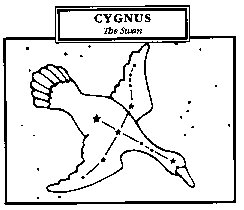|
The Constellation Cygnus - The
Swan
|

Mythology: Cygnus - The Swan
Just as he was beginning his life as a great Trojan hero, Cygnus
was tragically killed in battle by the famed and clever warrior,
Achilles. As Cygnus drew a last breath of life, his father, Poseidon,
transformed the young man into a beautiful swan and carried him to the
heights of Mount Olympus, home of the gods. Here, Cygnus displayed his
grand grace and elegance, inspiring the King of the Gods to change
himself into a swan, too. Disguised as the majestic creature, Zeus sped
to earth and courted the lovely Leda, who gave birth to their sons,
Castor and Pollux. Zeus also took the form of the swan to trick Nemesis,
the stern goddess of Divinity from Cygnus' attack. In the starry skies,
the great white swan forever flies, with wings outstretched, southward
along the Milky Way. |
Make a survey of the very rich area of the sky composed of Cygnus, Lyra,
Vulpecula, and Sagitta.. Here, in a relatively compact region,
are a wealth of objects to keep observers busy on an autumn night. Scanning this region with binoculars is a pure
joy, with field after field of star clusters and groupings everywhere you look. The listing of objects presented
on each page are just a few of the splendors waiting for you to observe.
M-39. Through binoculars, this open cluster is very impressive. It is large and bright and stands out
well from the background. I see it as having an overall triangular shape. Through a telescope, it loses some of
its impact, because of its size and the fact that it is not very concentrated to the center.
M-29. This small open cluster is seen through binoculars as a diamond shaped grouping of about 6-8 stars
in a nice field. In a telescope, the count increases to about 15 sparsely concentrated stars.
NGC 7000 - The North America Nebula. I usually see this best with the naked eye as a milky patch just to
the east of the bright star Deneb. The "Gulf of Mexico" region stands out particularly well. Try holding
an O-III or UHC filter in front of your eyes to increase the contrast. Then, as an added treat, use these filters
while looking through binoculars.
NGC 6969/6992-5 - The Veil Nebula. This is a large supernova remnant best seen at low power, divided into
two major segments. NGC 6969 is the more difficult to see, as the bright star 52 Cygni overwhelms it. NGC 6992-5
lies to the east, and shows a wealth of filamentary detail, especially when using a filter.
Alberio. This is a classic double star. Easily split, it shows a beautiful contrast of yellow-orange and
blue stars. Even if you're not a double star fan, try this one. You'll like it.
Article © Copyright Rick Raasch
Photos © Copyright Edward P. Flaspoehler, Jr.
Messier Objects in Cygnus
|
Con
|
Messier
|
Type
|
R.A.
|
Dec.
|
Mag.
|
Size
|
NGC#
|
|
Cyg
|
M29
|
Open Cluster
|
20h 23.9
|
38d 32
|
9.0
|
7.0'
|
6913
|
|
Cyg
|
M39
|
Open Cluster
|
21h 32.2
|
48d 26
|
5.5
|
32.0'
|
7092
|
The Constellation Home Page
Sponsored by the American Association of Amateur Astronomers.
EDITOR: Edward P. Flaspoehler, Jr.
Help support the development of the Constellation Home Page.
Become a member of the American Association
of Amateur Astronomers.
To join, send your name and address along with y our check for $20.00 ($25.00 family)
to the following address.
Unless otherwise indicated:
All Content © Copyright 1998 by The American Association of Amateur Astronomers
All rights reserved.
Go to Top of Constellation Home Page |